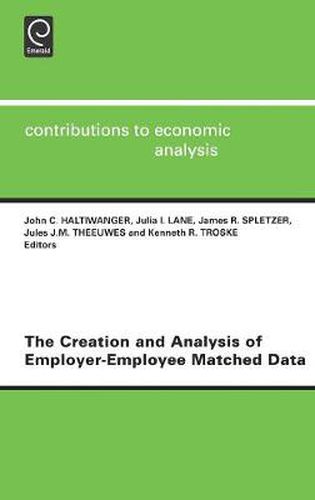Readings Newsletter
Become a Readings Member to make your shopping experience even easier.
Sign in or sign up for free!
You’re not far away from qualifying for FREE standard shipping within Australia
You’ve qualified for FREE standard shipping within Australia
The cart is loading…






This study consists of a selected subset of papers presented at the International Symposium of Linked Employer-Employee Data, held in Washington DC, in May 1998 - to address the creation and analysis of such matched data in an environment that safeguards respondent confidentiality. The conference brought together a wide range of social scientists and statisticians from more than 20 countries. Three broad themes are highlighted. The first of these is the analysis of linked employer-employee data. The basic finding of this and the next section is that the firm matters a good deal in explaining the differences in earnings, productivity, and work experiences of individual workers. Linked data allow the researcher to disentangle the firm effects from the worker effects. The second section examines econometric issues involved with the analysis of such data. Creating and analyzing employer-employee matched data sets presents a number of new econometric problems that are not present in standard micro-data sets containing just workers or just employers. However, these data also offer us a unique opportunity to examine the effects of some of the econometric problems involved in using the other data sources. The chapters in this section address both of these issues. The first two chapters examine new econometric issues involved in the creation and use of matched data sets, while the second two chapters use matched data to examine possible problems with cross-sectional or panel data on workers. The third section looks at ongoing efforts aimed at creating large-scale linked employer-employee data. It analyzes case studies involving both employers first and employees first methodologies. The 23 chapters in this book provide a glimpse into the future of labour economics and industrial organization. It can be said that labour economics and public policy around the world have been dominated over the past several decades by quantitative analyses based upon public-use US micro-data. In the future, it is very likely that economics and social policy in the United States and elsewhere will depend on quantitative analysis based on linked employer-employee micro-data currently residing in all continents of the world.
$9.00 standard shipping within Australia
FREE standard shipping within Australia for orders over $100.00
Express & International shipping calculated at checkout
This study consists of a selected subset of papers presented at the International Symposium of Linked Employer-Employee Data, held in Washington DC, in May 1998 - to address the creation and analysis of such matched data in an environment that safeguards respondent confidentiality. The conference brought together a wide range of social scientists and statisticians from more than 20 countries. Three broad themes are highlighted. The first of these is the analysis of linked employer-employee data. The basic finding of this and the next section is that the firm matters a good deal in explaining the differences in earnings, productivity, and work experiences of individual workers. Linked data allow the researcher to disentangle the firm effects from the worker effects. The second section examines econometric issues involved with the analysis of such data. Creating and analyzing employer-employee matched data sets presents a number of new econometric problems that are not present in standard micro-data sets containing just workers or just employers. However, these data also offer us a unique opportunity to examine the effects of some of the econometric problems involved in using the other data sources. The chapters in this section address both of these issues. The first two chapters examine new econometric issues involved in the creation and use of matched data sets, while the second two chapters use matched data to examine possible problems with cross-sectional or panel data on workers. The third section looks at ongoing efforts aimed at creating large-scale linked employer-employee data. It analyzes case studies involving both employers first and employees first methodologies. The 23 chapters in this book provide a glimpse into the future of labour economics and industrial organization. It can be said that labour economics and public policy around the world have been dominated over the past several decades by quantitative analyses based upon public-use US micro-data. In the future, it is very likely that economics and social policy in the United States and elsewhere will depend on quantitative analysis based on linked employer-employee micro-data currently residing in all continents of the world.